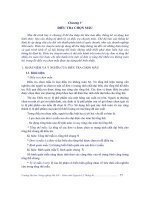LEADERSHIP STRATEGIES FOR PERSONAL SUCCESS phần 5 doc
Bạn đang xem bản rút gọn của tài liệu. Xem và tải ngay bản đầy đủ của tài liệu tại đây (40.83 KB, 15 trang )
CREATIVITY
Element #3 is originality, which is the ability to generate unusual
ideas. The fewer times an idea appears in any one group, the
more original the idea.
SM CR-21
CREATIVITY
Element #4 is awareness, which is the ability to see with your mind
and imagination as well as your eyes; the ability to see
possibilities, not just reality.
Element #5 is drive, which is the willingness to try and try again.
Refusal to give up.
THE CREATIVE PROCESS
Where do new ideas come from? An idea happens when someone
suddenly discovers a new combination of existing ideas or puts
into effect an adaptation of existing ideas. For example, the
increasing use of "slippery" water with 1 3/4" hose results in
maneuverability of 1 1/2" hose and gallons per minute of 2 1/2"
hose. For another example, computers in stations were originally
for dispatch and report writing. Now premise information (special
hazards, closest hydrants, best route, etc.) is becoming a common
use. Carried even further are the mobile digital terminals (MDTs)
which are computers in the cab of the fire truck!
Steps leading to new ideas:
Preparation is an initial awareness of a need for improvement or a
scoping out of the situation. (What's going on? What needs to be
changed?) The preparation stage lays the groundwork for
creativity. It is similar to the problem identification phase of
problem-solving, but more intuitive and less logical. The end result
is a mental definition (a sense) of your purpose why you need a
creative solution.
Once you're "hooked" you become absorbed in generating various
ideas. This step is called concentration.
When ideas run out, leave it alone for awhile. Sleep on it! This is
known as incubation.
Illumination is what happens when the "light bulb" goes on. It is
the "aha!" phase getting the answer or having a "feeling" or a
"hunch" that this is the way to go.
Verification/Production is testing the idea; talking about the idea
with others; trying out the solution to see if it works.
SM CR-22
CREATIVITY
THE "SCAMPER" TECHNIQUE
The concentration step described above can be enhanced by using
the "scamper" technique. "Scamper" questions are designed to
increase the fluency and flexibility of ideas generated. (The figure
below is from Idea Management: How To Motivate Creativity
and Innovation.)
S - C - A - M - P - E - R
FLUENCY
S - What can you substitute?
C - What can you combine?
A - What can you adapt?
M - What can you magnify, miniaturize, or multiply?
P - What can you put to other uses?
E - What else?
R - Can you rearrange or reverse?
S - C - A - M - P - E - R
DRIVE
FLEXIBILITY
AWARENESS
ORIGINALITY
Where else? Who else?
CREATIVITY BLOCKS
Each of us has certain "blocks" which inhibit our own creativity.
We unconsciously create secret excuses to avoid being creative or
innovative. Listed below are some of the most common blocks and
how to overcome them.
"I don't want to look foolish." We are not willing to suggest
something new in case someone might make fun of us or we fear
that looking foolish will undermine our professional image. We
SM CR-23
CREATIVITY
need to accept the fact that most new ideas get laughed at when
first proposed.
SM CR-24
CREATIVITY
"I don't want to fail." Don't view failure as the opposite of
success, rather as the way to success. We need to allow
ourselves to fail and recognize that we learn from mistakes. A
mistake is when we only miss the mark failure is when we stop
trying.
"I'm not creative." Research shows that the major difference
between creative and noncreative people is self-confidence.
"That's not my area (skill, style, etc.)." Overemphasis on
specialization limits creativity and allows us to build safe boxes
around ourselves. We need to open up to new situations,
challenges, opportunities.
"I don't get paid to have fun." There is a tendency to believe that
having fun is the opposite of work. Finding ways to make your job
fun (enjoyable) makes you a better employee.
FOSTERING CREATIVITY IN SUBORDINATES
Allowing yourself to be creative and overcoming your personal
blocks to creativity are important goals for everyone. But if you're
a supervisor, these are just the first steps you also have a
responsibility to encourage and help your subordinates to be
creative. In other words, you need to avoid saying or doing things
which inhibit creative/innovative ideas.
Killer phrases are responses to ideas or suggestions which make
the other person feel stupid and/or unimportant. Killer phrases
come in many forms and we've all been on the receiving end of
one at some time in our lives. Examples are: "We tried that before
and it didn't work;" "What's wrong with the way we do it now?" etc.
Supervisors need to be keenly aware of the debilitating effect of
killer phrases on others and constantly guard against
unintentionally turning off new ideas.
There are lots of other ways in which supervisors inhibit creativity,
sometimes without even realizing what they're doing. In The
Change Masters, Rosabeth Moss Kanter defines ten ways to stifle
creativity in subordinates. These "Rules for Stifling Creativity,"
which follow, are intended to be a humorous way to emphasize
those things supervisors must avoid.
Be suspicious. After all tailboard firefighters are dumb. How
could they possibly have any innovative ideas? Just because
SM CR-25
CREATIVITY
they're the end users of the tools, equipment, and procedures is no
reason to believe they can improve on anything.
Be inaccessible. Avoid giving approval on new ideas by making
yourself scarce. Say: "I don't have time right now!" After all, if
your name is on a recommendation, your bosses might think you're
slipping and what if it turns out to be a not-so-hot idea? You would
surely be blamed.
Pass the buck. If one of your crew has a good idea, make him/her
get the whole crew to approve of it. That way you can always say:
"They all said it was a good/lousy idea it wasn't my decision!"
Criticize at every opportunity. Don't ever tell them they did a
good job they'll probably get swell-headed. Constantly telling
them about things they do wrong will give them the incentive to do
better work. They most certainly should not be spending time on
new ideas when they can't even do things the good old-fashioned
way.
Discourage people from letting you know when there's a
problem. After all, most problems will go away if we just ignore
them. Anyway, only troublemakers would tell you about any
problems you might have.
Control everything carefully. Don't let your crew participate in
any decision-making. After all, you're the officer, you know what's
best for everyone and everything.
Make significant policy changes in secret. Change seniority
policies just before vacations are selected.
Keep people in the dark as much as possible. If your crew
knows too much they'll try to take over your job. Things will go
much smoother if only you have vital information.
Pass on your dirty work in the name of delegation and
participation. Wait until you have a day off and let your fill-in
handle those nasty tasks. You have to live there it wouldn't be fair
if you had to do it.
Finally, above all else, never forget that you, the supervisor,
know everything there is to know.
SM CR-26
CREATIVITY
CHARACTERISTICS OF SUPERVISORS WHO FOSTER CREATIVITY
They are willing to absorb the risks taken by subordinates. They
expect errors when trying something new. They defend
subordinate failures to upper management.
SM CR-27
CREATIVITY
They are comfortable with half-developed ideas. They have the
ability to pick out incomplete ideas that have potential. They don't
immediately focus on all the reasons why a new idea might not
work. They don't require all the answers before considering a new
idea.
They are able to make quick decisions. They don't procrastinate
approving pursuit of a good idea because they're afraid it might
fail. They don't use their own fears as an excuse to hold back
subordinates.
They are good listeners. They draw out the best ideas of
subordinates and add to them. They don't ram new policies down
the throats of subordinates; they listen to the other side and take it
into consideration.
They don't dwell on past mistakes. They practice the theory which
says, "When it's over, it's over." They are future-oriented, not past-
oriented.
They enjoy their jobs. They like being able to bring out creative
ideas from subordinates. They add energy to the workplace.
They expect subordinates to succeed. They use praise more than
criticism. They genuinely care about subordinates. They work at
helping subordinates enjoy their jobs.
They capitalize on subordinate strengths. They recognize unusual
talent and help it grow. They allow subordinates to get involved in
projects which show their strengths.
SELLING YOUR IDEAS TO TOP MANAGEMENT
Selling new ideas to top management is often more difficult than
generating them. We commonly make the mistake of assuming
that just because we've spent a lot of time and effort developing a
new procedure/technique/concept it will be immediately apparent to
others that it's a good idea worthy of adopting.
Unfortunately, this is rarely true! Getting others to accept and
adopt our ideas requires planning and effort on our part. The
planning process outlined below allows us to assess the
"sellability" of our ideas and provides pointers on how to persuade
others that our ideas are worth trying.
SM CR-28
CREATIVITY
Consider the following questions before proposing new ideas to
management:
1. Will your idea work? (Test it several times.) Is it practical?
Is it distinctly better than the present way?
2. Will people accept it? Will it improve quality? Will it
increase productivity? Will it use personnel more
effectively? Will it improve present methods of operation or
present equipment? Will it improve safety? Will it eliminate
unnecessary work? Will it reduce costs? Will it improve
working conditions?
3. Is your idea timely? Is it fully developed? Is top
management ready for it? If it's approved, are you ready to
act on it? Are you sure it doesn't conflict with other projects
that already have top-management approval/priority?
In order to develop a persuasive argument, emphasize how your
idea relates to a recognized need. Identify the most "sellable"
features of your idea. Evaluate the priorities of top management
(What's bothering them most right now? What do they care most
about?)
Emphasize the feature(s) of your idea which top management will
be most interested in.
Appeal to positive values. Emphasize the "ideal" qualities of your
idea. Relate your idea to "improved public service." Clearly spell
out the benefits to citizens, employees, etc.
Anticipate objections. Think of all the possible reasons why top
management may be reluctant to accept your idea. Build a
response to all possible objections into your initial proposal. Get
others involved. Whenever possible, work at building support for
your idea at your level first. Remember, there is strength in
numbers.
Ensure your credibility. Don't make false claims. Don't
exaggerate. Don't be defensive. If someone raises a question to
which you don't have an answer, offer to research the question and
provide a follow-up response.
SUMMARY
SM CR-29
CREATIVITY
Most individuals underestimate their own creative potential and
have a natural hesitation about getting involved in a creative
process. Hopefully, this module has convinced you that everyone
can be creative if they're willing to tear down the "blocks" they've
established in their lives.
SM CR-30
CREATIVITY
GLOSSARY
1. Creativity The ability to produce original ideas or products.
2. Creative awareness The ability to envision possibilities (potential) and
not just reality.
3. Creative drive Willingness to keep trying to find new ideas.
4. Creative flexibility The ability to generate ideas in different categories;
the ability to practice free association.
5. Creative fluency The quantity of ideas you can generate in a specific
period of time.
6. Creative originality The ability to generate ideas that others don't think
of.
7. Innovation The ability to improve a present practice, method, or product
by adaptation or alteration.
8. Killer phrase A quick response to a proposed idea which "turns off" the
proposer.
SM CR-31
CREATIVITY
SM CR-32
CREATIVITY
BIBLIOGRAPHY
Barnett, Camille Cates. The Creative Manager. Washington, D.C.: ICMA,
1986.
Campbell, David. Take the Road to Creativity and Get Off your Dead End.
Center for Creative Leadership.
Clark, Charles H. Idea Management: How to Motivate Creativity and Innovation.
New York: AMACOM, 1980.
Kanter, Rosabeth Moss. The Change Masters. New York: Simon and
Schuster, 1983.
Morgan, John S. Improve Your Creativity on the Job. New York: American
Management Association, 1968.
Van Oech, Roger. A Kick In The Seat of Your Pants. New York: Harper and
Row, 1986.
Van Oech, Roger. A Whack On The Side of The Head. New York: Warner
Books, 1988.
SM CR-33
LEADERSHIP
ENHANCING YOUR PERSONAL
POWER BASE
OBJECTIVES
The participants will:
1. Identify five types of power.
2. Identify the sources and limits of different types of power.
3. Differentiate between use and abuse of different types of power.
4. Explain how influencing and networking complement one's power base.
5. Identify potential activities for enhancing their power base.
6. Begin to develop a Personal Power Enhancement Plan.









